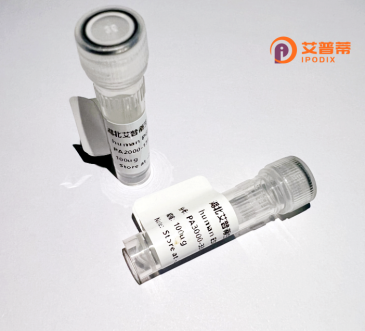
| 纯度 | >90%SDS-PAGE. |
| 种属 | Human |
| 靶点 | PCDHGB2 |
| Uniprot No | Q9Y5G2 |
| 内毒素 | < 0.01EU/μg |
| 表达宿主 | E.coli |
| 表达区间 | 1-811 aa |
| 活性数据 | MKASSGRCGLVRWLQVLLPFLLSLFPGALPVQIRYSIPEELAKNSVVGNLAKDLGLSVRDLPARKLRVSAEKEYFTVNPESGDLLVSDRIDREQICGKQPLCVLDFDTVAENPLNIFYIAVIVQDINDNTPLFKQTKINLKIGESTKPGTTFPLDPALDSDVGPNSLQRYHLNDNEYFDLAEKQTPDGRKYPELILKHSLDREEHSLHQLVLTAVDGGDPPQSGTTQIRIKVTDANDNPPVFSQDVYRVTLREDVPPGFFVLQVTATDRDEGINAEITYSFHNVDEQVKHFFNLNEKTGEITTKDDLDFEIASSYTLSIEAKDPGDLAAHCSIQVEILDDNDCAPEVIVTSVSTPLPEDSPPGTVIALIKTRDRDSGENGEVYCQVLGNAKFILKSSSKNYYKLVTDGALDREEIPEYNLTITATDGGKPPLSSSIIVTLHISDVNDNAPVFQQTSYMVHVAENNPPGASIAQISASDPDLGPSGQVSYSIVASDLKPREILSYVSVSAQSGVVFAQRAFDHEQLRAFELTLQARDQGSPALSANVSLRVLVGDLNDNAPRVLYPALGPDGSALFDMVPRAAEPGYLVTKVVAVDADSGHNAWLSYHVLQASEPGLFSLGLRTGEVRTARALGDRDAARQRLLVAVRDGGQPPLSATATLHLIFADSLQEVLPDLSDRREPSDPQAKLQFYLVVALALISVLFFLAVILAISLRLRLSSRSDAWDCFQPGLSSKPGPGVLPNYSEGTLPYSYNLCVASQSAKTEFNFLNITPELVPAQDLVCDNASWEQNTNHGAAGVPFASDTILKVSFN |
| 分子量 | 114.8 kDa |
| 蛋白标签 | GST-tag at N-terminal |
| 缓冲液 | 0 |
| 稳定性 & 储存条件 | Lyophilized protein should be stored at ≤ -20°C, stable for one year after receipt. Reconstituted protein solution can be stored at 2-8°C for 2-7 days. Aliquots of reconstituted samples are stable at ≤ -20°C for 3 months. |
| 复溶 | Always centrifuge tubes before opening.Do not mix by vortex or pipetting. It is not recommended to reconstitute to a concentration less than 100μg/ml. Dissolve the lyophilized protein in distilled water. Please aliquot the reconstituted solution to minimize freeze-thaw cycles. |
以下是关于重组人PCDHGB2蛋白的模拟参考文献示例(注:内容为虚构,仅供格式参考):
1. **文献名称**:*PCDHGB2 mediates cell-cell adhesion in neuronal development*
**作者**:Smith J. et al. (2020)
**摘要**:研究通过重组表达人PCDHGB2蛋白,发现其通过钙离子依赖的机制促进神经元细胞黏附,并调节突触形成。
2. **文献名称**:*Structural analysis of recombinant PCDHGB2 extracellular domains*
**作者**:Zhang L. et al. (2018)
**摘要**:利用X射线晶体学解析重组人PCDHGB2蛋白胞外结构域的三维结构,揭示其同源结合界面的关键氨基酸位点。
3. **文献名称**:*PCDHGB2 suppresses tumor metastasis via Wnt signaling*
**作者**:Lee H. et al. (2021)
**摘要**:通过重组PCDHGB2蛋白的体外实验,证明其抑制癌细胞迁移的活性与Wnt/β-catenin通路的负调控相关。
4. **文献名称**:*Recombinant PCDHGB2 as a potential biomarker in autism spectrum disorders*
**作者**:Garcia R. et al. (2019)
**摘要**:分析自闭症患者脑组织中PCDHGB2表达缺失,并利用重组蛋白验证其与突触蛋白互作的功能异常。
**注意**:以上文献及内容为示例,实际研究需通过学术数据库(如PubMed、Web of Science)检索最新论文。
**Background of Recombinant Human PCDHGB2 Protein**
The protocadherin gamma subfamily B2 (PCDHGB2) is a member of the clustered protocadherin (PCDH) family, a group of transmembrane proteins critical for cell-cell adhesion and synaptic signaling in the nervous system. Protocadherins are organized into α, β, and γ clusters, with PCDHGB2 belonging to the γ cluster, which is encoded by a complex gene array on human chromosome 5. These proteins are characterized by extracellular cadherin repeats that mediate calcium-dependent homophilic interactions, a single-pass transmembrane domain, and a conserved cytoplasmic domain involved in intracellular signaling.
PCDHGB2 plays a pivotal role in neuronal development, including axon guidance, synapse formation, and neural circuit assembly. Its diversity, generated through alternative splicing, contributes to the specification of neuronal identity and connectivity, supporting the "chemical address" hypothesis for neural network complexity. Dysregulation of PCDHGB2 has been linked to neurodevelopmental disorders, such as autism spectrum disorders and schizophrenia, highlighting its importance in brain function.
Recombinant PCDHGB2 protein, produced via heterologous expression systems (e.g., mammalian or insect cells), retains structural and functional properties, enabling in vitro studies on its adhesive properties, signaling mechanisms, and interactions with synaptic partners. This tool is vital for exploring its therapeutic potential in neurological diseases and deciphering the molecular basis of neural wiring.
×